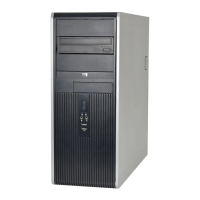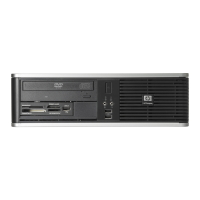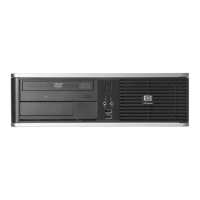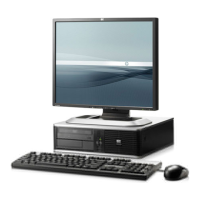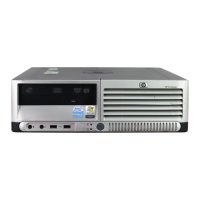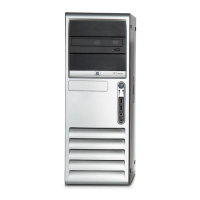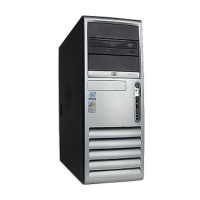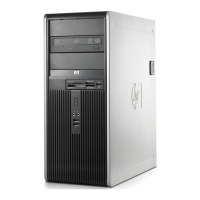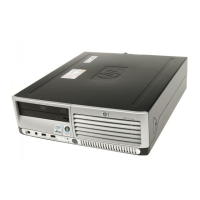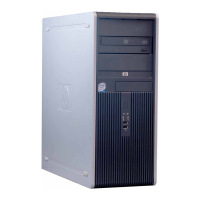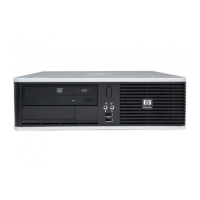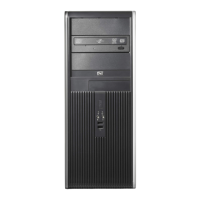Do you have a question about the HP Compaq dc7800 and is the answer not in the manual?
Describes the automatic operating system installation process.
Overview of the HP Backup and Recovery Manager application.
Explains the functions and capabilities of the Computer Setup utility.
Provides a step-by-step guide to access and navigate the Computer Setup utility.
Details security settings such as setup passwords, power-on passwords, and device security.
Introduces the utility for hardware diagnostics and configuration information.
Steps to access the HP Insight Diagnostics tool via a Recovery Disc Set.
Overview of HP tools for managing and updating software on desktops and notebooks.
Provides security features to protect against unauthorized access to data and systems.
Steps to set up an administrator password to prevent reconfiguration.
Steps to set a password that prevents computer access when powered on.
Steps to change existing power-on or setup passwords.
Explains how to set master or user passwords and enable DriveLock.
Explains when and how to use the FailSafe Key to open the cover.
Information on preventing damage from static electricity (ESD).
Diagram and explanation of populating DIMM sockets for optimal performance.
Step-by-step instructions for installing DIMMs into the memory sockets.
Guidelines for installing additional drives, including SATA and diskette connections.
Illustration and table identifying system board drive connectors (SATA, Media Card Reader, Diskette).
Information on supported hard drives and the 2.5-inch drive carrier.
Steps to remove an external 3.5-inch drive, requiring prior optical drive removal.
Initial safety procedures and steps before disassembling the USDT chassis.
Step-by-step instructions for installing SODIMM memory modules.
Steps for removing an optical drive from the chassis.
Troubleshooting for processor thermal protection issues indicated by LED flashes and beeps.
Troubleshooting for pre-video memory errors indicated by LED flashes and beeps.
Troubleshooting for system board failures indicated by LED flashes and beeps.
Troubleshooting for system power-on issues indicated by LED flashes and beeps.
Troubleshooting for bad option cards indicated by LED flashes and beeps.
Troubleshooting for processor feature incompatibility indicated by LED flashes and beeps.
Troubleshooting for systems that do not power on or display flashing LEDs.
Troubleshooting systems that do not power on or display flashing LEDs.
Solutions for intermittent power supply shutdowns.
Troubleshooting processor thermal protection and fan issues.
Solutions for hard disk errors like bad sectors or drive failure.
Solutions for issues preventing the computer from booting from the hard drive.
Solutions for blank screen issues, including monitor and connection checks.
Solutions for printer issues where the printer will not print.
Solutions for when keyboard input is not recognized.
Solutions for when a new device is not recognized by the system.
Solutions for when the computer will not start, potentially due to memory issues.
Troubleshooting graphics card or system board issues.
Troubleshooting issues related to bad option cards.
Solutions for boot or function issues after adding memory.
Ensures a memory module is installed in the black XMM1 socket.
Recommends replacing modules or checking seating for type/speed grade issues.
Solutions for poor processor performance, such as overheating or fan issues.
Troubleshooting processor seating or installation issues.
Solutions for processor feature incompatibility issues.
Solutions for preventing the computer from booting from CD-ROM or DVD drives.
Solutions for preventing the computer from booting from a USB Drive Key.
Solutions for inability to connect to the Internet.
Troubleshooting steps when the computer does not proceed past the POST stage.
Solutions for issues occurring after the HP logo screen appears.
| Tcase | 73.3 °C |
|---|---|
| Bus type | FSB |
| Stepping | M0 |
| Processor cache | 2 MB |
| Processor cores | 2 |
| Processor model | E4600 |
| System bus rate | - GT/s |
| Processor family | Intel® Core™2 Duo |
| Processor series | Intel Core 2 Duo E4000 Series |
| Processor socket | LGA 775 (Socket T) |
| Processor codename | Conroe |
| Processing Die size | 111 mm² |
| Processor frequency | 2.4 GHz |
| Processor cache type | L2 |
| Processor lithography | 65 nm |
| Processor manufacturer | Intel |
| Processor front side bus | 800 MHz |
| Processor operating modes | 64-bit |
| ECC supported by processor | No |
| Thermal Design Power (TDP) | 65 W |
| CPU multiplier (bus/core ratio) | 12 |
| Number of Processing Die Transistors | 167 M |
| Internal memory | 1 GB |
| Internal memory type | DDR2-SDRAM |
| Maximum internal memory | 8 GB |
| Memory layout (slots x size) | 2 x 0.5 GB |
| HDD speed | 7200 RPM |
| HDD interface | SATA |
| Optical drive type | DVD Super Multi |
| Total storage capacity | 160 GB |
| Audio input | 1 |
| LightScribe | Yes |
| Networking features | Intel 82566DM Gigabit Network Connection |
| Graphics card RAMDAC | 400 MHz |
| Storage drive controller | SATA 3, 0 Gb/s NCQ SMART VI |
| Discrete graphics card model | Intel® GMA 3100 |
| Maximum graphics card memory | 0.256 GB |
| Operating system installed | Windows Vista Business |
| USB 2.0 ports quantity | 8 |
| Chassis type | Mini Tower |
| Country of origin | China |
| Cable lock slot type | Kensington |
| Operating altitude | 0 - 3048 m |
| Non-operating altitude | 0 - 9144 m |
| Storage temperature (T-T) | -30 - 60 °C |
| Operating temperature (T-T) | 10 - 35 °C |
| Storage relative humidity (H-H) | 5 - 95 % |
| Operating relative humidity (H-H) | 10 - 90 % |
| Power supply | 365 W |
| Product type | PC |
| Processor code | SLA94 |
| Processor ARK ID | 32242 |
| Processor package size | 37.5 x 37.5 mm |
| Depth | 452 mm |
|---|---|
| Width | 177 mm |
| Height | 447 mm |
| Weight | 11800 g |
